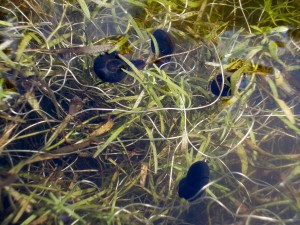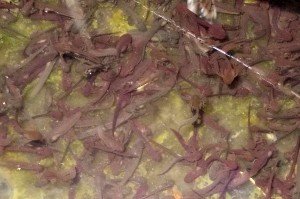On a grey rainy day, I put on my waterproofs and go down to the Gunnersbury Triangle reserve. A newly-fledged Green Woodpecker flies off. The cow parsley has taken over the whole of the meadow by the approach ramp; last year there really wasn’t very much of it, but now the tall white umbels are quickly turning to seed-heads across the whole area: they need to be pulled up quickly before they ripen. They are accompanied by quite a lot of cleavers (sticky-grass), nettles, hogweed, even hops twining their tall fibrous way over the other plants. And a few brambles are coming up again: we had a blitz a year or two ago, pulling out most of them, and the meadow is much improved, but that hasn’t saved the rather nice garlic mustard (good for orange tip butterflies) from the cow parsley invasion.
I loosen one bunch of roots after another with a fork, and pull up the cow parsley roots – much like carrots, they’re in the same family. When the soil is shaken off they are a pale brown, some straight and carroty, some branched into five smaller swollen roots. When I have a big armful, I carry them down to the dead-hedge.
Digging again, a nettle manages to sting me lightly through the leather-and-cloth gardening gloves. I hear a screaming sound and look up: eleven swifts are wheeling together high overhead, the most I’ve seen over this part of town this year, indeed for many a long while. Sixty or more sometimes gather over the lakes at the London Wetland Centre, pausing to feed before moving on up north on their spring migration.
I gather another armful of cow parsley. The meadow is starting to look a little better. I pull a six-foot stick out of the herbage; half-a-dozen diversely coloured white-lipped land snails, some plain yellow, some striped with black, fall out on to the path. The polymorphism has been argued over by ecologists: it might be camouflage adapted to different backgrounds, some lighter, some darker; or more interestingly, it might be a way of defeating predators like Song Thrushes which could be searching for snails of a particular pattern, so if a bird had learnt that snails were striped and had that ‘search image’, that bird might not spot plain snails, perhaps.
It comes on to rain. I help out in the hut, making preparations for Bug Day when we hope the reserve will be buzzing with excited children and their parents. They will be welcomed by a smiling ‘GunnersBee’, who is a black-and-yellow cutout on a huge blue card with yellow cutout flowers. Even in the drizzle, several species of real bumblebees are busy gathering pollen and nectar.


